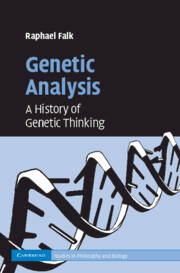Book contents
- Frontmatter
- Contents
- List of figures
- Acknowledgments
- Introduction
- PART I FROM REPRODUCTION AND GENERATION TO HEREDITY
- PART II FAKTOREN IN SEARCH OF MEANING
- PART III THE CHROMOSOME THEORY OF INHERITANCE
- PART IV GENES AS THE ATOMS OF HEREDITY
- PART V INCREASING RESOLVING POWER
- PART VI DEDUCING GENES FROM TRAITS, INDUCING TRAITS FROM GENES
- PART VII WHAT IS TRUE FOR E. COLI IS NOT TRUE FOR THE ELEPHANT
- Concluding comments
- Bibliography
- Index
PART VII - WHAT IS TRUE FOR E. COLI IS NOT TRUE FOR THE ELEPHANT
Published online by Cambridge University Press: 07 August 2009
- Frontmatter
- Contents
- List of figures
- Acknowledgments
- Introduction
- PART I FROM REPRODUCTION AND GENERATION TO HEREDITY
- PART II FAKTOREN IN SEARCH OF MEANING
- PART III THE CHROMOSOME THEORY OF INHERITANCE
- PART IV GENES AS THE ATOMS OF HEREDITY
- PART V INCREASING RESOLVING POWER
- PART VI DEDUCING GENES FROM TRAITS, INDUCING TRAITS FROM GENES
- PART VII WHAT IS TRUE FOR E. COLI IS NOT TRUE FOR THE ELEPHANT
- Concluding comments
- Bibliography
- Index
Summary
Thus eventually one may hope to have the whole of biology “explained” in terms of the level below it, and so on right down to the atomic level. And it is the realization that our knowledge on the atomic level is secure which has led to the great influx of physicists and chemists into biology.
Crick (1966, 14)… the analysis of the hierarchy of living things shows that to reduce this hierarchy to ultimate particles is to wipe out our very sight of it. Such analysis proves this ideal to be both false and destructive.
Polanyi (1968, 1312)By 1960, with Crick's Central Dogma and the statement that “once the central and unique role of proteins is admitted there seems little point in genes doing anything else” (Crick, 1958, 139), genetics' determinism reached its peak. Jacob and Monod's analysis of “genetic regulatory mechanisms in the synthesis of proteins” further provided the logical extension of Crick's physico-chemical reduction of genetics. In their opening sentences they state that “the ‘structural gene’ accounts for the multiplicity, specificity and genetic stability of protein structures, and it implies that such structures are not controlled by environmental conditions or agents” (Jacob and Monod, 1961, 318). But then, throughout their study they take us through “genes” that do not qualify for that model. This starts with “primary products of the i+ gene,” the repressor which “may be a polyribonucleotide” (Jacob and Monod, 1961, 333; this turned out to be wrong), and ends with the site of the repressor's interaction which they called “operator,” that coordinately regulates the heterocatalytic activity of the “operon” – a battery of structural genes.
- Type
- Chapter
- Information
- Genetic AnalysisA History of Genetic Thinking, pp. 245 - 248Publisher: Cambridge University PressPrint publication year: 2009



